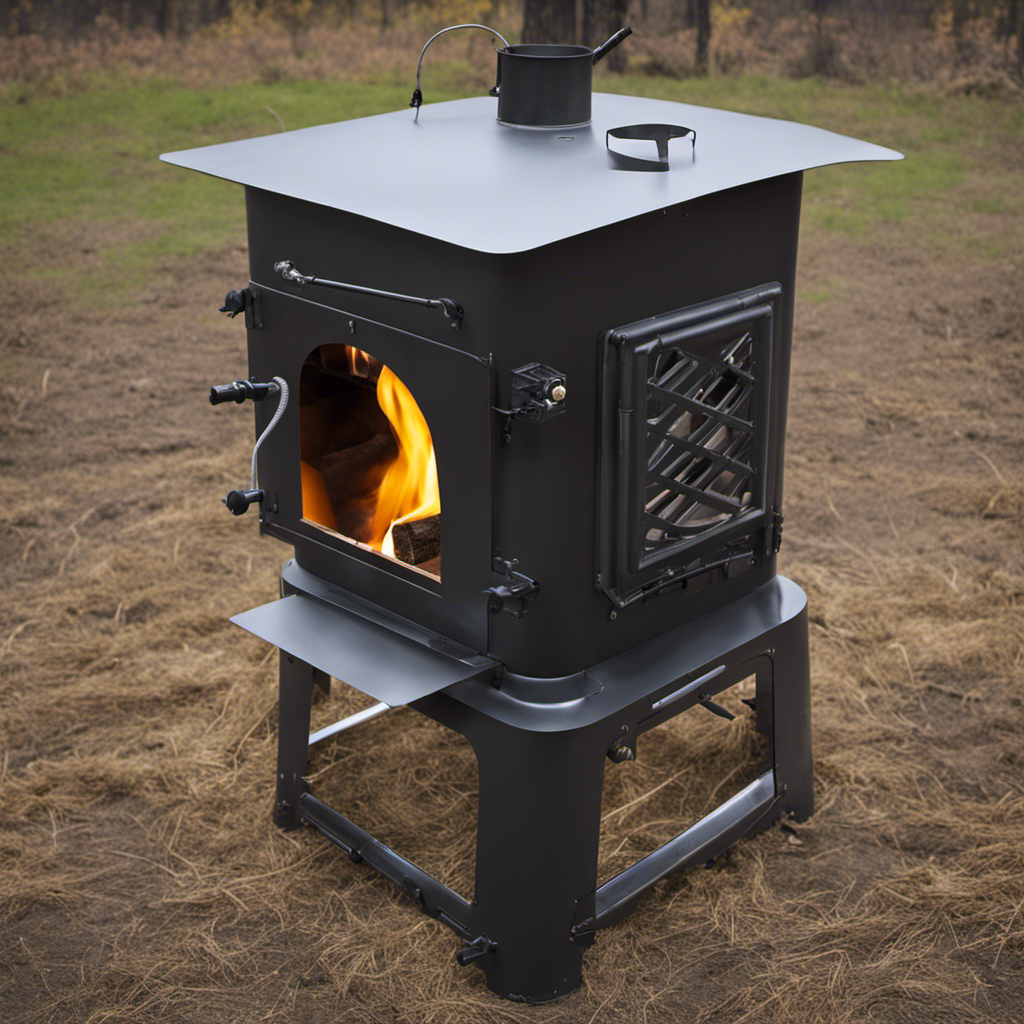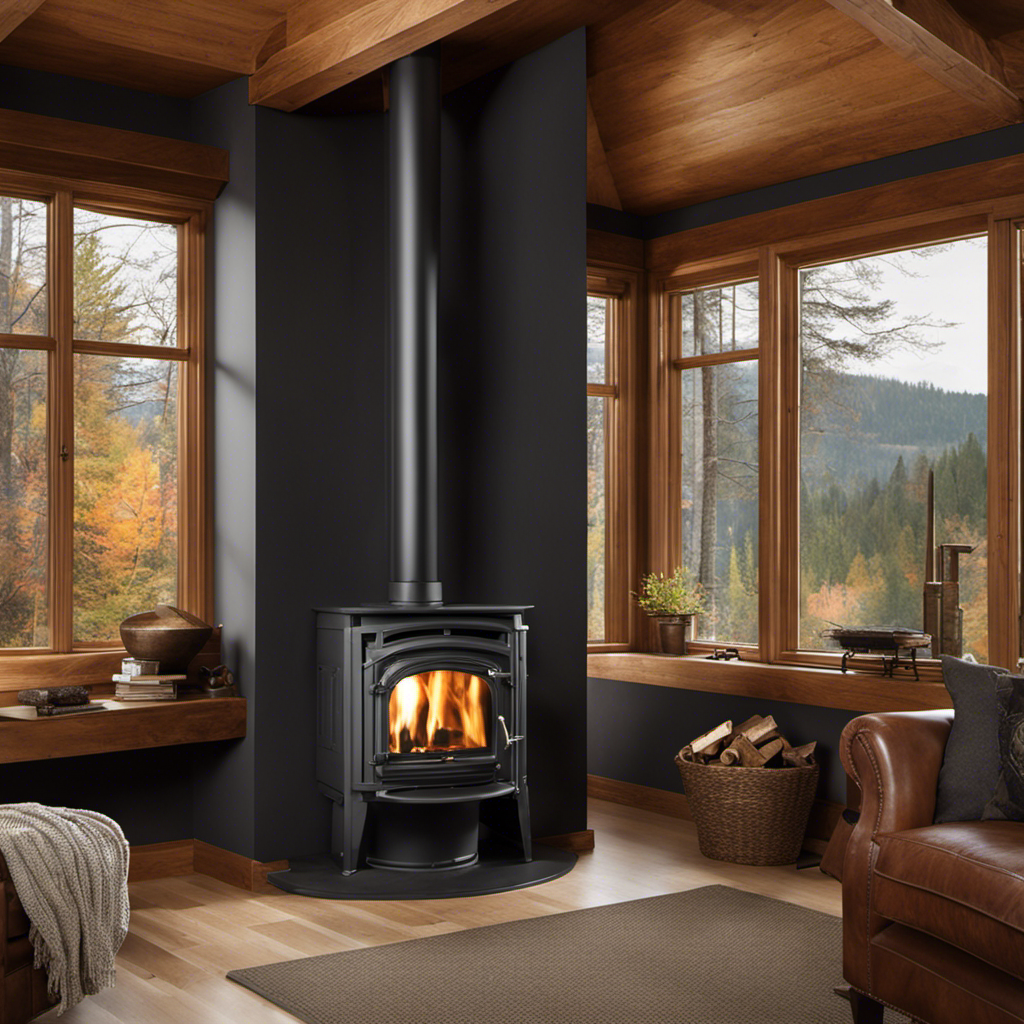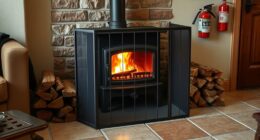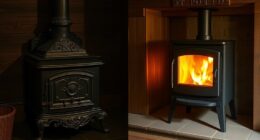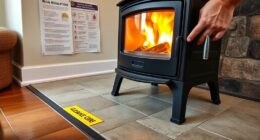I have always held the belief that a new layer of paint can revitalize anything, and this certainly applies to cast iron wood stoves. If you want to transform your old wood stove into a stunning visual piece, you are in the right spot.
In this step-by-step guide, I’ll walk you through the process of painting your cast iron wood stove, from surface preparation to choosing the right paint, and all the essential tools and materials you’ll need.
Get ready to transform your wood stove into a work of art!
Key Takeaways
- Inspect the wood stove surface for rust or loose paint before painting.
- Choose a high-temperature enamel paint that can withstand temperatures up to 1200°F.
- Gather necessary tools such as wire brush, sandpaper, high-temperature enamel paint, and a clean cloth.
- Take safety precautions by wearing protective gloves, goggles, and a mask while painting.
Preparing the Wood Stove Surface
I’m carefully inspecting the wood stove surface for any rust or loose paint. Before painting a cast iron wood stove, it’s important to ensure that the surface is clean and free from any imperfections.

To begin, I gather the necessary cleaning materials: a wire brush, sandpaper, and a damp cloth.
I start by using the wire brush to remove any loose rust or paint flakes from the surface. Next, I use sandpaper to smooth out any rough spots or remaining rust.
Once the surface is clean and smooth, I wipe it down with a damp cloth to remove any dust or debris.
Now that the wood stove is clean, I can move on to the priming process, which will be discussed in the next subtopic.

Choosing the Right Paint for Your Wood Stove
After researching different types of heat-resistant coatings, I’ve decided to go with a high-temperature enamel for my project. Now comes the fun part – choosing the right color for my wood stove!
When it comes to painting a rusty wood stove, there are a few tips to keep in mind. First, make sure to clean and prepare the surface properly before painting. Remove any rust or loose paint with a wire brush and sandpaper.
Next, choose a high-quality, heat-resistant paint that’s specifically designed for metal surfaces. Look for a paint that can withstand temperatures up to 1200°F to ensure durability.
Lastly, consider the color options available for wood stoves. Popular choices include black, charcoal, and metallic finishes. Choose a color that complements your home decor and personal style.

With these tips in mind, I’m confident my wood stove won’t only be functional but also look great in my space.
Tools and Materials You’ll Need
To complete this project, I’ll need a wire brush, sandpaper, high-temperature enamel paint, and a clean cloth.
Before painting your wood stove, it’s important to choose the right primer. Look for a primer that’s specifically designed for high-temperature applications to ensure the paint adheres properly and lasts longer.
Safety precautions while painting your wood stove are crucial. Make sure to wear protective gloves, goggles, and a mask to prevent any contact with harmful chemicals or fumes. It’s also important to work in a well-ventilated area to avoid inhaling any paint fumes. Taking these precautions will help ensure a successful and safe painting experience.

Now, let’s move on to the step-by-step guide to painting your wood stove.
Step-by-Step Guide to Painting Your Wood Stove
As I begin the step-by-step guide, I carefully prepare the surface of the wood stove. First, I gather the necessary tools and materials: sandpaper, wire brush, rust dissolver, cleaner, and primer.
Then, I follow these tips for removing rust from a wood stove:
- Start by sanding the rusted areas to remove loose particles.
- Use a wire brush to scrub away any remaining rust.
- Apply a rust dissolver to further remove stubborn rust spots.
After the rust is removed, I move on to properly cleaning the wood stove before painting:

- Use a cleaner specifically designed for wood stoves to remove dirt and grime.
- Rinse the surface thoroughly and allow it to dry completely.
- Apply a primer to ensure proper adhesion of the paint.
With the surface prepared, I’m ready to move on to the next section, where I’ll discuss finishing touches and maintenance tips to keep my wood stove looking its best.
Finishing Touches and Maintenance Tips
To maintain the appearance of my newly refurbished wood stove, I regularly wipe down the exterior with a clean, damp cloth. This helps to remove any dust or dirt that may accumulate over time.
When cleaning the wood stove, it’s important to avoid using abrasive materials or harsh chemicals, as these can damage the paint job. Instead, opt for a mild soap or specialized stove cleaner. Gently scrub the surface using a soft cloth or sponge, paying extra attention to any stubborn stains.
After cleaning, make sure to thoroughly dry the stove to prevent any water damage.

In addition to regular cleaning, I also recommend periodically applying a coat of high-temperature stove paint to keep the surface looking fresh and protected.
Frequently Asked Questions
How Do I Clean and Prepare the Wood Stove Surface Before Painting?
I clean and prepare the wood stove surface before painting by using cleaning methods such as scrubbing with a wire brush and sanding. I recommend using high-temperature paint for a durable finish.
Can I Use Regular Household Paint on a Cast Iron Wood Stove?
Regular household paint is not recommended for a cast iron wood stove. Instead, use high-temperature paint specifically designed for this purpose. It will withstand the heat and adhere better to the surface, ensuring a long-lasting finish.
What Safety Precautions Should I Take When Painting My Wood Stove?
When painting a wood stove, it’s important to take safety precautions. Some safety measures include wearing protective clothing, using a respirator, ensuring proper ventilation, and keeping a fire extinguisher nearby.

How Long Should I Wait for the Paint to Dry Before Using the Wood Stove Again?
After painting my wood stove, I waited for the paint to dry completely before using it again. The drying time depends on the type of paint used, but generally, it takes about 24-48 hours. It’s important to choose heat-resistant paint for this task.
Are There Any Specific Maintenance Tips to Keep the Painted Wood Stove in Good Condition?
Maintenance tips for a painted wood stove include regular cleaning with a soft cloth, avoiding abrasive cleaners, and inspecting for common paint problems like chipping or peeling. Stay vigilant to keep it in good condition.
Conclusion
Painting your cast iron wood stove is a simple yet rewarding DIY project that can breathe new life into your heating source. Just like a fresh coat of paint can transform a room, painting your wood stove can bring warmth and beauty to your space.
By following the step-by-step guide provided and choosing the right paint, you can ensure a successful and long-lasting finish.

So go ahead, unleash your creativity, and give your wood stove the makeover it deserves.
Growing up surrounded by the vast beauty of nature, Sierra was always drawn to the call of the wild. While others sought the comfort of the familiar, she ventured out, embracing the unpredictable and finding stories in the heartbeat of nature.
At the epicenter of every remarkable venture lies a dynamic team—a fusion of diverse talents, visions, and passions. The essence of Best Small Wood Stoves is crafted and refined by such a trio: Sierra, Logan, and Terra. Their collective expertise has transformed the platform into a leading authority on small wood stoves, radiating warmth and knowledge in equal measure.




